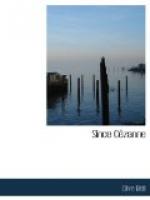[Illustration: OTHON FRIESZ]
Matisse, to whom, not fifteen years ago, I saw a picture of his attributed by a competent amateur who was the friend of both.
Friesz has an air of being more professional than any other artist of this first rank—for Marchand, I think, is not quite of it. Indeed, for a moment, Friesz may appear alarmingly professional. Certainly, he leaves nothing to chance: all is planned, and planned not in haste and agitation, fingers itching to be at it, but with the deliberation, the critical thoroughness, of an engineer or an architect. There is so much of the painstaking craftsman in his method that for a moment you may overlook the sensitive artist who conceives and executes. But, in fact, the effective alliance of practical intelligence with fine sensibility is the secret of his strength, as I realized one day, when I had the privilege of studying a large decoration (a sketch for a fragment of which is to be seen in this exhibition) [V] which Friesz had just carried out. Since then I have not doubted that he was the man who might give this age that of which the age talks much and gets little—monumental decoration.
[Footnote V: At the Independent Gallery, 1921.]
Large decorative schemes—when they are not, what most are, mere wastes of tumid pomposity—are apt to fail for one of two reasons: either they are too much like pictures or too little like works of art. Because very few artists are capable by taking thought of adapting their means to an unfamiliar end, it will happen that a sensitive and gifted painter sets about a decoration as though he were beginning an easel picture. He has his sense of the importance of richness, of filling a picture to the brim; he has a technique adequate to his conception; but he has neither the practical readiness nor the intellectual robustness which would enable him to adjust these to a new problem. He endeavours, therefore, to key every part of his scheme up to the highest pitch of intensity that line and colour can bear. He is attempting the impossible; his conception is inappropriate; and, in any case, his technique is unequal to so vast an undertaking. He produces something which may be delicious in detail but is pretty sure to be unsatisfactory as a whole. He fails to fill his space. His work has the vice of Sidney’s Arcadia and the Religio Medici: it is good to dip into. You cannot write an epic as though it were a sonnet.
On the other hand, you must not write an epic as though you were telling a tale in the bar-parlour, lest you should create another Earthly Paradise, leaving quite untouched the subtler and more energetic chords in your listener’s appreciative faculty. The craftsman decorator, though he may know how to fill vast spaces, will never fill them with lively images. His plan may be cleverly devised to surmount difficulties of structure and material; it will not be inspired. Incapable of keying his instrument too high, he will be satisfied with a slack string and abominable flatness. His forms will be conventional; his handling impersonal; ten to one he will give us a row of insipid Gothic figures or something in the pseudo-Veronese taste.




